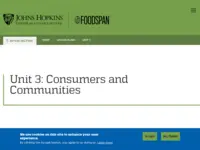Consumers and Communities
https://foodspan.org/lesson-plans/unit-3-consumers-and-communities
https://foodspan.org/lesson-plans/unit-3-consumers-and-communities
Johns Hopkins Center for a Livable Future
This unit provides a comprehensive overview of the economic, social, and cultural aspects of the food system in the United States. The full lesson set includes a combination of life and social science, and this unit mainly focuses on the social science side of things.
This learning activity takes six 60 minute class periods.
Learn more about Teaching Climate Literacy and Energy Awareness»Grade Level
Regional Focus
Online Readiness
Topics
Climate Literacy
This Activity builds on the following concepts of Climate Literacy.
Click a topic below for supporting information, teaching ideas, and sample activities.
Notes From Our Reviewers
The CLEAN collection is hand-picked and rigorously reviewed for scientific accuracy and classroom effectiveness.
Read what our review team had to say about this resource below or learn more about
how CLEAN reviews teaching materials
Teaching Tips | Science | Pedagogy |
Technical Details
Teaching Tips
- Consider adding a final presentation and discussion whereby student groups choose an extension activity and present their finding to the class.
- The graphic in the full lesson set overview is helpful for considering whether it will be most useful for you to focus on individual lessons, this unit, or all three units. It may also help teachers in different subjects coordinate if you choose to co-teach this lesson set.
About the Content
- This resource is part of a series of three food systems units. This unit examines how the food system affects consumers and communities, and builds on the previous two units that described the model and outcome for industrialized food systems. Once food is produced, factors such as marketing, labeling, socioeconomic status, and government policy influence what food people are able to eat and how it impacts their health.
- This unit focuses mainly on the social sphere of food systems, and touches on subjects related food waste, food insecurity, and climate risk and vulnerability. Each of the six lessons in the unit provides opportunities to take a deeper dive into the scientific concepts included.
- Passed initial science review - expert science review pending.
About the Pedagogy
- The lessons use infographics, short classroom activities, slides, and thoughtful discussions to suit a variety of learning styles. Extension activities include videos as well to engage students with alternative activities.
- This unit is the final of three in this in the larger lesson set and covers lessons 10-15. It may be helpful to have students start with lessons A and B (unit one) and/or lessons one through nine (unit two) if they are not already somewhat familiar with the topic.
- Lessons 10-15 focus on the social, economic, and cultural aspects of the food system while Unit 2 focuses mainly on food production, harvest, and transport, and Unit 1 serves as an introduction.
- There is a lot of content here and you're likely to be able to find a lesson that suits your needs if you're focused on food-related topics at a high school level.
Technical Details/Ease of Use
- All resources are organized and easy to download and use from a web browser. The "Lesson plan with handouts and slides" link is broken, however all content is available piece-wise through the Unit 3 webpage.
- Suggest that users who wish to employ this lesson first access the general website to access tables that identify education standards and the videos that ground the lessons.
- There is some prep involved for teachers to have the cards ready if you choose to teach those lessons.








